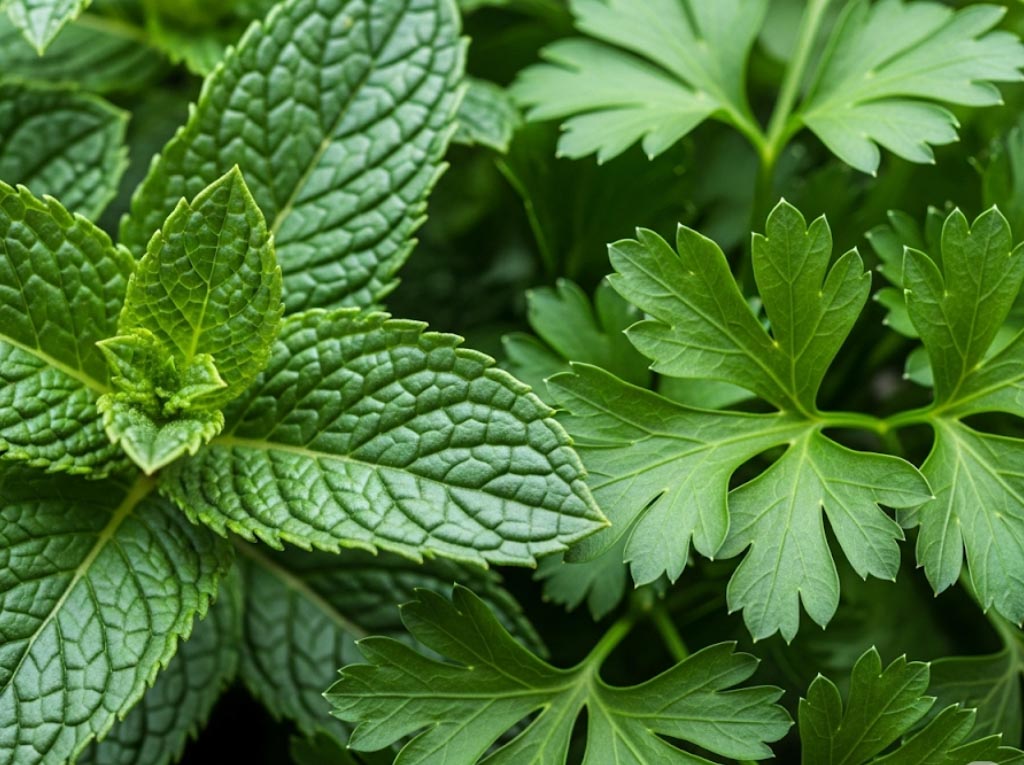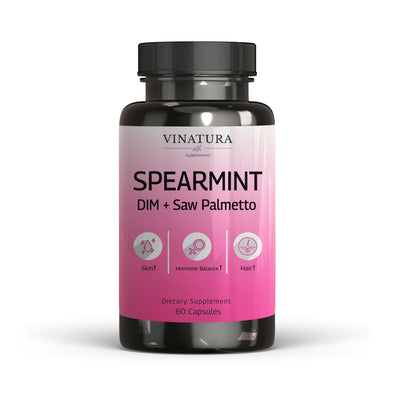
Parsley and Mint: Natural Duo to Fight Body Odor
Body odor is a common concern that can quietly undermine confidence, whether in social gatherings or professional environments. As awareness grows about the downsides of chemical deodorants, like synthetic additives or skin irritation, more people are turning to natural alternatives.
Among the most promising are parsley and mint: a dynamic herbal duo renowned for their detoxifying and deodorizing powers. Could these humble herbs be the key to feeling fresher, naturally?
Before exploring further, please read the disclaimer located at the end of this webpage.
Key Takeaways
- Parsley & mint may reduce body odor via chlorophyll & menthol.
- Use fresh supplements or topically for odor control.
- Daily use for 2–4 weeks may show results.
- Pair with a low-sugar, low-red-meat diet for best effect.
- Consult a doctor before long-term supplement use.
Overview: Mint and Parsley – What Are They?
Parsley (Petroselinum crispum) is a vibrant, aromatic herb widely used in kitchens worldwide. Packed with chlorophyll, vitamins (like C, A, and K), and minerals (such as iron and calcium), it’s celebrated for its fresh flavor and potential deodorizing properties [1].
Mint (Mentha spp.), known for its cool, refreshing scent, contains menthol-rich essential oils that support digestion and offer antibacterial benefits [5,12]. This herb’s diverse species, like peppermint and spearmint, bring a burst of flavor and bioactive compounds to the table.

Together, parsley and mint are a dynamic duo in both culinary and wellness practices. Their complementary flavors enhance dishes like salads, smoothies, and sauces, while their natural compounds such as chlorophyll in parsley and menthol in mint work synergistically to freshen breath and support odor control [3].
This makes them a popular choice for those seeking natural ways to stay fresh, seamlessly connecting to their potential role in addressing body odor, as explored in the next section.
Why Parsley and Mint May Help With Body Odor
Parsley and mint have long been appreciated for their refreshing qualities, and recent studies suggest they may also help reduce body odor. These herbs support detoxification, improve digestion, and offer antibacterial effects—each addressing different causes of unpleasant smells.
Parsley is especially rich in chlorophyll, the green pigment structurally similar to protoheme, a component in hemoglobin that carries oxygen in the blood. This similarity may help explain how chlorophyll supports the liver in removing toxins like dioxins, which contribute to body odor [13].
By aiding detoxification and boosting oxygen levels in the blood, parsley can help reduce internal sources of odor, such as those from sweat or breath [4]. Its root has even shown the ability to neutralize strong odors like garlic [1].
However, a 2014 study by Munch and Barringer found that chlorophyllin, a semi-synthetic version of chlorophyll, had only limited effects on garlic breath. This suggests that other natural compounds in parsley may be responsible for its deodorizing effects [8].
Mint contributes to odor control primarily by supporting digestive health. When the gut is out of balance, it can produce foul-smelling chemicals. Menthol, one of mint’s main active compounds, acts like a natural digestive aid by relieving bloating and indigestion [5].
In 2017, Castada found that phenolic compounds in mint, such as rosmarinic acid, can bind to volatile sulfur compounds and reduce their presence in breath [3]. Mint may also help maintain a healthy gut microbiome, which plays a key role in limiting the production of odor-causing amines like beta-phenylethylamine (PEA) [18].
Beyond its digestive benefits, mint’s essential oils are rich in menthol and possess antibacterial properties. These oils can help reduce odor-causing bacteria on the skin, such as Staphylococcus aureus [2,6].
A 2024 study by Hazaa and colleagues confirmed that peppermint oil was effective against a range of microbes, including E. coli and Candida albicans—organisms that break down sweat into odorous compounds [2].
Parsley also exhibits antibacterial activity. Its essential oils and leaf extracts have been shown to inhibit bacteria such as Bacillus subtilis and E. coli [1].
Meanwhile, chlorophyll continues to support detoxification, which helps reduce the accumulation of odor-causing toxins [13]. Menthol from mint also produces a cooling sensation, enhancing the feeling of freshness [5].

Together, parsley and mint create a synergistic effect. A 2017 study by Castada and colleagues found that peppermint and spearmint leaves, especially when paired with rosmarinic acid and enzymes like polyphenol oxidase, significantly reduced volatile sulfur compounds associated with garlic odor [3].
When peppermint leaves were combined with rosmarinic acid, the deodorizing effects were even stronger, suggesting that multiple compounds can work in harmony to neutralize odor [3]. This synergy likely extends to body odor, addressing both internal (gut and detoxification) and external (skin bacteria) sources.
On Reddit, user Raven-Ray shared their positive experience using a parsley and mint supplement, noting that it reduced odors in underarms, breath, and other areas within a week.*
They credited the supplement’s effectiveness to ingredients such as chlorophyll, parsley, and peppermint, while also mentioning the cost and unregulated nature of such supplements. They recommended chlorophyll water as a more budget-friendly option, reinforcing the potential of these herbs in odor control.*
How to Use Mint and Parsley to Reduce Body Odor
Fresh Mint and Parsley

Fresh parsley and mint, when combined, offer a natural way to support digestion and potentially reduce body odor. Their chlorophyll and bioactive compounds make them ideal for teas, smoothies, and meals, blending seamlessly into your daily routine for a refreshing boost.
For a soothing tea, steep 1-2 tablespoons of fresh parsley and a handful of mint leaves in boiling water for 5-10 minutes, strain, and sip warm, optionally with honey [15]. This duo’s essential oils aid digestion, with parsley boosting bile production and mint easing bloating, possibly reducing gut-related odors [1,5].
Blend parsley and mint with cucumber, lemon, or apple for a nutrient-rich smoothie. These additions, rich in polyphenolic compounds, may support detoxification and neutralize odors, enhancing the herbs’ chlorophyll-driven benefits [4,8].
In meals, toss parsley and mint into salads, soups, or sauces for a burst of flavor and nutrition, including vitamins (C, A, K) and minerals [1].
The YouTube channel Kravings features a TABOULEH Parsley & Mint Salad, showcasing their vibrant synergy*. Both herbs’ antibacterial properties may help balance gut and skin microbes, potentially minimizing odor [1,2].
Should You Take Parsley and Mint Supplements?
Parsley Supplements: When choosing parsley supplements, look for products made from parsley leaves and manufactured in GMP-certified facilities. Clear dosage instructions on the label can also help ensure consistent quality and safe use.
Mint Oil Capsules and Chlorophyll Drops:
Mint oil capsules, rich in menthol, menthone, and menthyl acetate, support digestion and may freshen breath, with studies showing rapid effects on physiological parameters after oral use [5]. Their bioactive compounds, including menthol, contribute to antibacterial and anti-inflammatory benefits, potentially reducing odor-causing microbes [5,16].
Chlorophyll drops, often paired with peppermint in products like Chlorofresh, combine sodium copper chlorophyllin—a chlorophyll derivative—with peppermint oil to support detoxification and neutralize odors in breath, urine, or sweat [13].
Derived from green plants like parsley and mint, chlorophyll may aid in flushing toxins via the liver, complementing peppermint’s digestive support [4, 13].
However, high doses of chlorophyllin may cause side effects like nausea or discolored stool, so use with care [13]. Products blending these ingredients, such as parsley-mint-chlorophyll capsules, maximize their synergistic effects for a natural, odor-fighting boost.
For optimal odor control, products combining parsley and mint leverage their synergistic deodorizing powers, blending phenolic compounds, enzymes, and essential oils [3,17]. Consider formulations like Chlorofresh, which pairs peppermint oil with sodium copper chlorophyllin for enhanced freshness [13].
Peppermint is often preferred over other mint varieties due to its high menthone content, along with menthol, menthofuran, isopulegone, and pulegone, all of which contribute to its potent aroma and deodorizing effects [15].
Effective recipes include capsules with organic parsley leaf and peppermint oil, or liquid drops mixing chlorophyll with mint extract, maximizing their antioxidant and antibacterial benefits for a natural, holistic boost [1,5].

A reviewer on Amazon, Vladyslava, praised a mint and parsley deodorizing supplement for significantly reducing body odor within a week, even after workouts or stressful days.*
By carefully weighing the benefits and precautions, you can determine whether parsley and mint supplements are a suitable addition to your health regimen.
Topical use with Mint and Parsley
While parsley and mint work internally to support freshness, they can also be used externally to target odor directly.
Creating a toner or body mist by boiling parsley and mint leaves, straining, and cooling the liquid offers a refreshing rinse to apply after showering, leveraging their antibacterial properties to combat odor-causing bacteria on the skin [1,2].
Alternatively, blend fresh parsley and mint with coconut oil and baking soda for a natural deodorant paste, ideal for underarms. Diluted mint essential oil, applied to pulse points, provides a cooling, odor-fighting effect, but should be used cautiously on sensitive skin to minimize the risk of irritation [13].

Tips for Effective Use of Mint and Parsley Dou
To maximize the potential deodorizing benefits of parsley and mint, a few practical strategies can make a difference.
By timing their use thoughtfully, maintaining consistency, and pairing them with a balanced diet, you can enhance their effectiveness in supporting freshness, building on the ways to incorporate them discussed earlier.
For optimal results, consume parsley and mint, whether as tea, smoothies, or supplements, in the morning on an empty stomach.
This timing may enhance their ability to neutralize odor-causing compounds, such as volatile sulfur compounds from foods like garlic, thanks to parsley’s chlorophyll and mint’s rosmarinic acid, which work together to form odorless complexes [3,4].
Consistency is key—using these herbs daily for 2–4 weeks may lead to noticeable improvements in odor control.
Studies show that parsley’s antioxidant enzymes increase within a week of regular consumption, while mint’s essential oils can offer immediate digestive support, suggesting sustained use amplifies their benefits [1,5].
Pairing parsley and mint with a clean diet low in sugar and red meat can further support their effects. Diets high in these foods may contribute to odor by disrupting gut microbiota, which produce compounds like β-phenylethylamine (PEA) linked to body odor [9,18].
A diet rich in whole foods complements the herbs’ digestive and detoxifying properties, potentially reducing odor triggers.
By following these tips, you can enhance the parsley and mint duo’s role in your odor-fighting routine. The next section covers potential side effects to ensure safe use.
Mint and Parsley: Potential Side Effects or Precautions
Parsley and mint are generally safe in culinary amounts, but concentrated forms like supplements may pose risks. Below are key precautions to ensure safe use in your odor-fighting routine.
Mint:
- Sensitivity: Peppermint oil may cause skin irritation or allergic reactions in sensitive individuals, especially if undiluted [13]. High doses of mint supplements can trigger heartburn or acid reflux, particularly in those with GERD [13].
- Digestive Issues: Excessive mint oil capsules may cause nausea or stomach discomfort [13].
Parsley:
- Diuretic Effect: Parsley’s mild diuretic properties may increase urine production, potentially problematic for those with kidney issues [1].
- Pregnancy Risks: High doses of parsley supplements may cause uterine contractions, so pregnant women should avoid them [1].
General Precautions:
- Supplements: Long-term use of parsley or mint supplements, including chlorophyllin, may cause side effects like green urine or nausea [13]. Consult a healthcare professional before extended use, especially with health conditions or medications [1, 13].
- Allergies: Both herbs may cause skin or digestive reactions in some people [1].
These precautions help ensure the safe use of parsley and mint. The next section summarizes their role in a holistic odor-control approach.
Conclusion
Parsley and mint offer a natural, versatile approach to managing body odor, seamlessly fitting into your routine through teas, smoothies, meals, supplements, or topical applications. Their combined benefits, from digestive support to potential deodorizing effects, make them a compelling choice for those seeking holistic freshness.
By using them consistently and mindfully, alongside good hygiene and a balanced diet, you can enhance your confidence and well-being. Curious to explore more natural wellness solutions? Consider how other herbs might complement your journey to a fresher you.
Testimonial Disclaimer
*The testimonials presented on this website are provided by individuals based on their personal experiences with our products. These testimonials represent individual opinions and experiences, which may not be typical or applicable to all users of our products. Results may vary depending on a variety of factors, including individual health, lifestyle, and adherence to product usage instructions.References
- [1] Punoševac, Milka, et al. “A Review of Botanical Characteristics, Chemical Composition, Pharmacological Activity and Use of Parsley.” Archives of Pharmacy, vol. 71, no. Notebook 3, 7 June 2021, pp. 177–196, https://doi.org/10.5937/arhfarm71-31544.
- [2] M.M. Hazaa, et al. “The Combination between Some Medical Oils Antibiotics and Its Effect on Some Pathogenic Micro Organism.” Benha Journal of Applied Sciences, vol. 5, no. 6, 1 Sept. 2020, pp. 1–8, https://doi.org/10.21608/bjas.2020.137081. Accessed 18 Nov. 2024.
- [3] Castada, Hardy Z., et al. “Deodorization of Garlic Odor by Spearmint, Peppermint, and Chocolate Mint Leaves and Rosmarinic Acid.” LWT, vol. 84, Oct. 2017, pp. 160–167, https://doi.org/10.1016/j.lwt.2017.05.064.
- [4] Arathi Kizhedath. “Estimation of Chlorophyll Content in Common Household Medicinal Leaves and Their Utilization to Avail Health Benefits of Chlorophyll.” Journal of Pharmacy Research, vol. 4, no. 5, 1 Jan. 2011, pp. 1412–1413, www.researchgate.net/publication/299499753_Estimation_of_chlorophyll_content_in_common_household_medicinal_leaves_and_their_utilization_to_avail_health_benefits_of_chlorophyll.
- [5] Abbas Meamarbashi. “Instant Effects of Peppermint Essential Oil on the Physiological Parameters and Exercise Performance.” Avicenna Journal of Phytomedicine, vol. 4, no. 1, Jan. 2014, p. 72, pmc.ncbi.nlm.nih.gov/articles/PMC4103722/.
- [6] Jagetia, Ganesh Chandra, and Manjeshwar Shrinath Baliga. “Influence of the Leaf Extract of Mentha Arvensis Linn. (Mint) on the Survival of Mice Exposed to Different Doses of Gamma Radiation.” Strahlentherapie Und Onkologie, vol. 178, no. 2, 1 Feb. 2002, pp. 91–98, https://doi.org/10.1007/s00066-002-0841-y. Accessed 7 Mar. 2023.
- [7] Bienenstock, John, et al. “Disruptive Physiology: Olfaction and the Microbiome-Gut-Brain Axis.” Biological Reviews, vol. 93, no. 1, 4 July 2017, pp. 390–403, https://doi.org/10.1111/brv.12348.
- [8] Munch, Ryan, and Sheryl A. Barringer. “Deodorization of Garlic Breath Volatiles by Food and Food Components.” Journal of Food Science, vol. 79, no. 4, 4 Mar. 2014, pp. C526–C533, https://doi.org/10.1111/1750-3841.12394. Accessed 18 Apr. 2020.
- [9] Peterson, James A. “SHAREABLE RESOURCE.” ACSMʼs Health & Fitness Journal, vol. 22, no. 3, 2018, p. 48, https://doi.org/10.1249/fit.0000000000000393. Accessed 14 Aug. 2020.
- [10] Yashin, Alexander, et al. “Antioxidant Activity of Spices and Their Impact on Human Health: A Review.” Antioxidants, vol. 6, no. 3, 15 Sept. 2017, p. 70, https://doi.org/10.3390/antiox6030070.
- [11] Michalak, Monika. “Plant-Derived Antioxidants: Significance in Skin Health and the Ageing Process.” International Journal of Molecular Sciences, vol. 23, no. 2, 6 Jan. 2022, p. 585, https://doi.org/10.3390/ijms23020585.
- [12] Zhang, Jiguang, et al. “Comparative Investigation on Aroma Profiles of Five Different Mint (Mentha) Species Using a Combined Sensory, Spectroscopic and Chemometric Study.” Food Chemistry, vol. 371, Mar. 2022, p. 131104, https://doi.org/10.1016/j.foodchem.2021.131104.
- [13] Ulbricht, Catherine, et al. “An Evidence-Based Systematic Review of Chlorophyll by the Natural Standard Research Collaboration.” Journal of Dietary Supplements, vol. 11, no. 2, 26 Mar. 2014, pp. 198–239, https://doi.org/10.3109/19390211.2013.859853. Accessed 30 Aug. 2021.
- [14] Sahu, Anurag, et al. “International Journal of Scientific Research for Global Innovation a Review on Parsley Herbs: Used on Urinary Tract Infection Treatment.” Volume, vol. 01, p. 2024, ijsrgi.com/PDF/Journals/2024/volume-1-issue-2/paper7.pdf. Accessed 9 June 2025.
- [15] Souza, J. M. de, Cargnelutti Filho, A., Pezzini, R. V., Somavilla, F. M., Heinzmann, B. M., & Rodrigues, P. (2024). Production and composition of peppermint essential oil in seasons after summer and winter transplantations. Comunicata Scientiae, 15, e3873. https://doi.org/10.14295/cs.v15.3873
Author

Product Disclaimer
Including an ingredient or study does not evaluate, endorse, or recommend any Vinatura product or any third-party product. Some ingredients discussed may not be used in any Vinatura product.
The content of the articles has not been evaluated by the Food and Drug Administration (FDA) and is not intended to promote or endorse any specific product. Any products sold on this website are not intended to diagnose, treat, cure, or prevent any disease.
Opinions and Endorsements
Any claims, statements, or opinions expressed in the articles are those of the author(s) and do not necessarily reflect the views or opinions of the manufacturers of the dietary supplement products. The products sold on this website are separate from the content of the articles and are not directly endorsed or associated with the information presented here.
Liability Disclaimer
The author(s) of the articles, website, and manufacturers of the dietary supplement products do not assume any liability for any potential consequences arising from the use of the information provided in the articles. Ingredient effects, dosages, and safety vary by individual, formulation, and context; some ingredients interact with medications or may be unsuitable during pregnancy or lactation. It is recommended that individuals consult with a qualified healthcare professional before making any dietary or lifestyle changes, including the use of dietary supplements.
Product Usage
Please refer to the product labels and packaging for specific usage instructions and guidelines for the dietary supplement products sold on this website.
Customer Support
For any concerns or questions regarding the dietary supplement products, please contact our customer support team, who will be more than happy to assist you.





Leave a Comment
Be the first to comment.
What do you think?